| dc.description.abstract | An accumulation of ice and snow on pavement slabs and bridge decks always adversely impacts driving conditions and results in motorist accidents. The use of the more popular deicing methods, including plowing, salting, and sanding, is limited by their relatively high cost for materials, fuel, maintenance, and labor. Geothermal energy, which is considered a renewable, sustainable, clean (i.e., zero carbon emission), and directly used energy source, has been successfully applied to bridges and pavements for deicing. However, existing geothermal bridge and pavement deicing designs are primarily employed for new bridges where hydronic loops, which are considered internal heating, are embedded in the concrete deck during the bridges’ construction. An alternative external geothermal heating system has been developed, in which hydronic loops are attached to the bottom of the bridge deck and encapsulated in a layer of spray foam to heat existing pavement slabs and bridge decks under severe winter events.
This research study is based on an accurate understanding of the heat transfer mechanism of an externally heated hydronic slab and on a comprehensive numerical analysis of the heating requirements and expected performances of the external system. A heated concrete slab was fabricated and installed in an environmental chamber in the structural lab at the University of Texas at Arlington (UTA), and with the help of COMSOL software, the slabs were replicated to analyze the heating performance of the external design. The slab-scale finite element model was fully calibrated by 16 laboratory heating response tests under time-dependent and stationary approaches that were used to simulate the complex heat transfer mechanisms of an externally heated deck and predict its steady-state surface temperatures under various ambient below-freezing temperatures. The results of the transient heating processes indicated temperature deviations, however, and the temperature drop at the interface zone (interface heat transfer) needs to be validated.
One internally and one externally heated concrete blocks were utilized to investigate two critical interface heat transfers, convective heat loss from the environment and thermal contact between PEX pipes and the concrete, by employing a series of heating tests that were performed in a freezer box. This study aims to utilize theoretical contributions to develop an updated thermal contact model and the convective coefficient to develop more finite element models that comprehensively understand the heat transfer process that occurs in an externally heated bridge deck. The improved results will, for the first time, be utilized in COMSOL to simulate the heating tests conducted in the freezer box and to obtain better agreements of the temperature profiles along the vertical direction and transient heating processes between the measured and simulated results.
In this study, the external geothermal bridge deicing system was deployed on a mock-up bridge deck in the field and was tested during several winter events with non-heating, heating, and deicing tests. A 3-dimensional Multiphysics finite element model of the heated deck was developed in COMSOL and fully calibrated with the results of the field tests in the transient analyses. The predicted temperatures of the FEM models were compared with the thermocouple readings at the inlet and outlet of the bridge loops, at different depths of the bridge decks in the simulated winter tests. In the calibrated FEM model, a record snowfall that occurred in the spring of 2015 was simulated by applying the equivalent heat flux loss needed for melting the snow on the deck. The heated bridge deck maintained a minimum temperature of 0.3 °C (32.6 °F) during the snow event, with a supplied inlet temperature of 43.3 °C (110 °F); the flux loss on the deck surface was around 220 W/m2. The FEM model was capable of providing satisfactory simulations of bridge heating during winter events. The external geothermal bridge deicing system maintained a snow-free deck during the record snow event and is ready for implementation.
Finally, a series of design charts were developed by utilizing the reformative model to perform the design process of an externally heated bridge deck under parametric studies. This is the first numerical design guideline to be performed in this research area. | |


